Comprehensive exhibition divided into eight thematic emphases highlights periods in the artist’s oeuvre
Marking the transition from historicism to Jugendstil, Gustav Klimt’s oeuvre shaped the beginning of modern art in Vienna. 100 years after his death, the Leopold Museum pays tribute to the leading figure in Vienna around 1900 with a comprehensive exhibition divided into eight thematic emphases and illustrating all the periods of the artist’s oeuvre by means of some 35 paintings, 90 drawings, 30 photographs and approx. 150 archival documents.Along with exhibits from the Leopold Museum and the Leopold Private Collection, the exhibition also features numerous works given to the museum by a Klimt descendant as a new permanent loan, as well as four paintings and six drawings from a private collection, which were also entrusted to the museum as permanent loans. The presentation further includes select loans from Austrian and international collections, and for the first time provides comprehensive insights into the collection of the Klimt Foundation, which acts as scientific research and cooperation partner to this exhibition.
The presentation Gustav Klimt. Artist of the Century traces an arc from Klimt’s beginnings at the height of the Gründerzeit era dominated by historicism, via his artistic paradigm shift and the evolution of his own, individual style from the mid-1890s, when he created his first drafts for the Faculty Paintings for the ceremonial hall of Vienna University, which would cause a scandal. The overview continues with Gustav Klimt as a leading figure of the Vienna Secession, whose members broke with esthetical conventions and paved the way for Jugendstil, and goes on to shine the spotlight on his activities as a sought-after portraitist of the wealthy Viennese bourgeoisie as well as on his highly erotic, symbolistically charged female depictions.
Sommer sojourns in the Salzkammergut region – Klimt’s landscapes
Gustav Klimt’s regular summer sojourns on the Attersee with Emilie Flöge and her family set in around the turn of the century. Klimt’s need for privacy and distance was especially great after the controversy caused by his Faculty Paintings. Far from the city and surrounded by intimate friends, Klimt found both relaxation and inspiration. A selection of his works created during these stays in the Salzkammergut region can be seen in the exhibition.
“Along with exceptional works from international collections and from the museum’s own holdings, a new permanent loan is now on display at the Leopold Museum – Klimt’s only Viennese landscape, the work Schönbrunn Landscape (1916). Klimt’s landscapes make up around one quarter of his painterly oeuvre. They were predominantly created in nature, or at times from photographs and picture postcards in his Vienna studio. The artist wanted to depict a natural environment independent of man that reflects a tranquil atmosphere – his interest in a symbolic expression and in aspects of timelessness and transience were central to these works,” explains Hans-Peter Wipplinger, the curator of the exhibition.
Death and Life and The Bride enter into a dialogue for the first time
The exhibition sees two monumental allegorical works by Klimt enter into a dialogue for the first time: Death and Life (1910/11, reworked in 1915/16) has been part of the Leopold Museum’s collection compiled by Rudolf Leopold for 40 years, while The Bride(1917/18) was brought into the collection of the Klimt Foundation in 2013. Since the Faculty Paintings, Gustav Klimt had addressed the cycle of life and its individual phases.
During the last years of his oeuvre, and shaped by personal experiences, Klimt started to rework the first version of Death and Life in 1915 and transferred depictions of individual stages of life as solitary figures to his work The Bride. The paintings, which are both shown in the exhibition, were prepared by Klimt with numerous drawings. The sketchbook for his last allegory has survived, and affords valuable insights into the process of the work’s composition and creation.
“The first presentation of drawings along with the extant sketchbook and the painting The Bride from the collection of the Klimt Foundation allows visitors to delve directly into the fantasies and visions of this exceptional artist. The painting further affords scope for new interpretations and, through its Expressionist accents, links Gustav Klimt as a pioneer of modernism in Austria with his successors Oskar Kokoschka and Egon Schiele,” according to the exhibition’s curator Sandra Tretter.
Image may be NSFW.
Clik here to view.
Clik here to view.
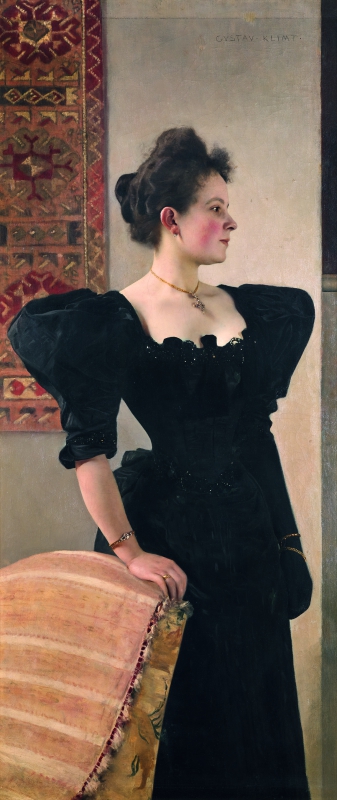
GUSTAV KLIMT
1862–1918
FRAUENBILDNIS, UM 1893
PORTRAIT OF A WOMAN, C. 1893
Öl auf Leinwand
| Oil on canvas
155 × 75 cm
Belvedere, Wien, 2013, Dauerleihgabe aus Privatbesitz
Belvedere, Vienna, 2013, Permanent loan from private collection
Foto
| Photo:
Belvedere, Wien
| Vienna/
Johannes Stoll
Image may be NSFW.
Clik here to view.![]()
Clik here to view.

GUSTAV KLIMT
1862–1918
KLARA KLIMT, UM 1880
KLARA KLIMT, C. 1880
Öl auf Leinwand
| Oil on canvas
30,3 × 21,3 cm
ARGE Sammlung Gustav Klimt/Dauerleihgabe im Leopold Museum, Wien
ARGE Collection Gustav Klimt/Permanent loan, Leopold Museum, Vienna
Foto
| Photo:
Leopold Museum, Wien
| Vienna/
Manfred Thumberger
Image may be NSFW.
Clik here to view.![]()
Clik here to view.

GUSTAV KLIMT
1862–1918
SITZENDES JUNGES MÄDCHEN, UM 1894
SEATED YOUNG GIRL, C. 1894
Öl auf Holz
| Oil on wood
14,1 × 9,6 cm
Leopold Museum, Wien
| Vienna
Foto
| Photo:
Leopold Museum, Wien
| Vienna/
Manfred Thumberger
Image may be NSFW.
Clik here to view.![Drawings 1 / Studie für 'Schubert am Klavier' 1898 Studie für 'Schubert am Klavier' 1898]()
Clik here to view.

GUSTAV KLIMT
1862–1918
SCHUBERT AM KLAVIER (ENTWURF), 1896
SCHUBERT AT THE PIANO (STUDY)
Öl auf Leinwand
| Oil on canvas
30 × 39 cm
Privatsammlung/Dauerleihgabe im Leopold Museum, Wien
Private collection/Permanent loan, Leopold Museum, Vienna
Foto
| Photo:
Leopold Museum, Wien
| Vienna/
Manfred Thumberger
Image may be NSFW.
Clik here to view.![]()
Clik here to view.
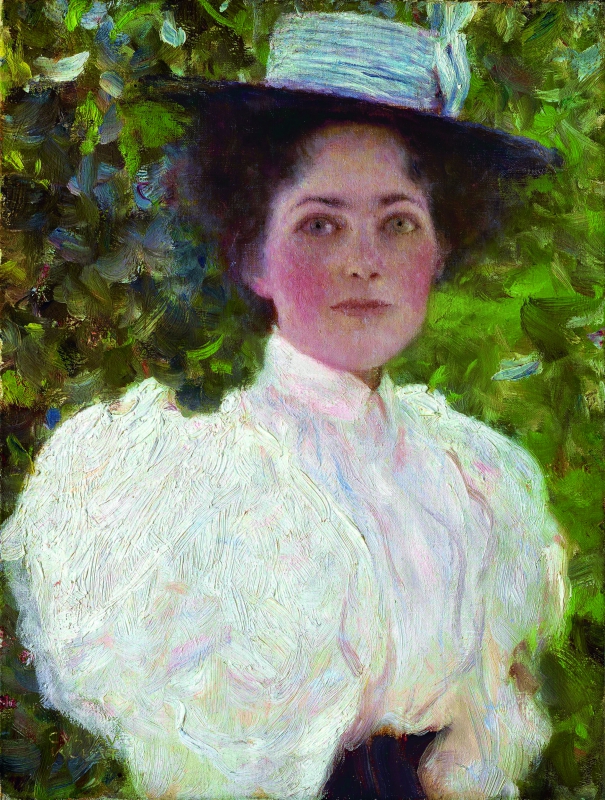
GUSTAV KLIMT
1862–1918
MÄDCHEN IM GRÜNEN, 1896–1899
GIRL IN THE FOLIAGE
Öl auf Leinwand
| Oil on canvas
32,4 × 24 cm
Klimt-Foundation, Wien
| Vienna
Foto
| Photo:
Klimt-Foundation, Wien
| Vienna
Image may be NSFW.
Clik here to view.![]()
Clik here to view.

GUSTAV KLIMT
1862–1918
AM ATTERSEE, 1900
ON LAKE ATTERSEE
Öl auf Leinwand
| Oil on canvas
80,2 × 80,2 cm
Leopold Museum, Wien
| Vienna
Foto
| Photo:
Leopold Museum, Wien
| Vienna/
Manfred Thumberger
Image may be NSFW.
Clik here to view.![]()
Clik here to view.

GUSTAV KLIMT
1862–1918
DIE GROSSE PAPPEL II (AUFSTEIGENDES GEWITTER), 1902/03
THE LARGE POPLAR II (GATHERING STORM)
Öl auf Leinwand
| Oil on canvas
100,8 × 100,8 cm
Leopold Museum, Wien
| Vienna
Foto
| Photo:
Leopold Museum, Wien
| Vienna/
Manfred Thumberger
Image may be NSFW.
Clik here to view.![]()
Clik here to view.

GUSTAV KLIMT
1862–1918
OBSTGARTEN AM ABEND, 1898
ORCHARD IN THE EVENING
Öl auf Leinwand
| Oil on canvas
69 × 55,6 cm
Privatsammlung/Dauerleihgabe im Leopold Museum, Wien
Private collection/Permanent loan, Leopold Museum, Vienna
Foto
| Photo:
Leopold Museum, Wien
| Vienna/
Manfred Thumberger
Image may be NSFW.
Clik here to view.![]()
Clik here to view.

GUSTAV KLIMT
1862–1918
TANNENWALD I, 1901
PINE FOREST I
Öl auf Leinwand
| Oil on canvas
90,5 × 90 cm
Kunsthaus Zug, Stiftung Sammlung Kamm
Foto
| Photo:
Kunsthaus Zug, Stiftung Sammlung Kamm/Alfred Frommenwiler
Image may be NSFW.
Clik here to view.![]()
Clik here to view.
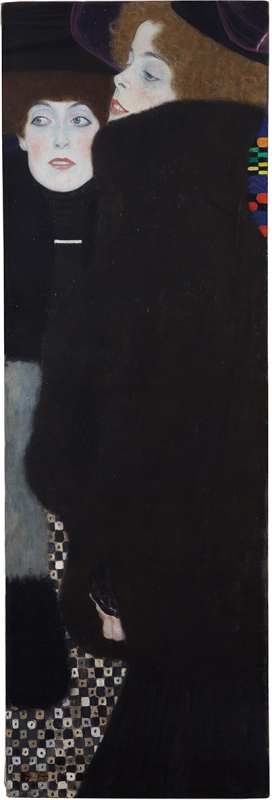
GUSTAV KLIMT
1862–1918
FREUNDINNEN I (DIE SCHWESTERN), 1907
FRIENDS I (SISTERS)
Öl auf Leinwand
| Oil on canvas
125 × 42 cm
Klimt-Foundation, Wien
| Vienna
Foto
| Photo:
Klimt-Foundation, Wien
| Vienna
Image may be NSFW.
Clik here to view.![]()
Clik here to view.

GUSTAV KLIMT
1862–1918
SCHÖNBRUNNER LANDSCHAFT, 1916
SCHÖNBRUNN LANDSCAPE
Öl auf Leinwand
| Oil on canvas
110 × 110 cm
Privatbesitz
| Private collection
Foto
| Photo:
Leopold Museum, Wien
| Vienna/
Manfred Thumberger
Image may be NSFW.
Clik here to view.![]()
Clik here to view.

GUSTAV KLIMT
1862–1918
TOD UND LEBEN, 1910/11, UMGEARBEITET 1915/16
DEATH AND LIFE, REWORKED IN 1915/16
Öl auf Leinwand
| Oil on canvas
180,8 × 200,6 cm
Leopold Museum, Wien
| Vienna
Foto
| Photo:
Leopold Museum, Wien
| Vienna/
Manfred Thumberger
Image may be NSFW.
Clik here to view.![]()
Clik here to view.
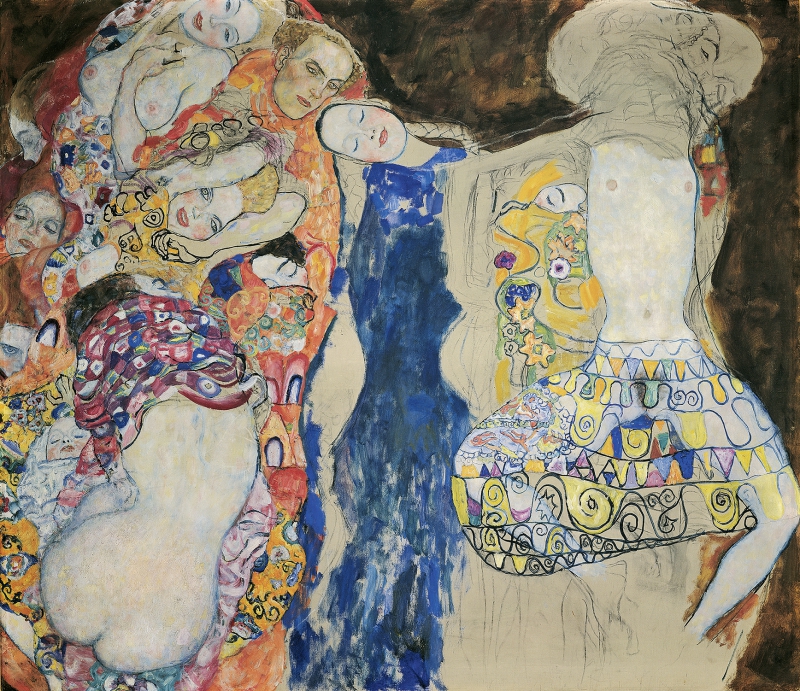
GUSTAV KLIMT
1862–1918
DIE BRAUT, 1917/18 (UNVOLLENDET)
THE BRIDE, 1917/18 (UNFINISHED)
Öl, schwarze Kreide auf Leinwand
| Oil, black chalk on canvas
165 × 191 cm
Klimt-Foundation, Wien
| Vienna
Foto
| Photo:
Klimt-Foundation, Wien
| Vienna
Image may be NSFW.
Clik here to view.![]()
Clik here to view.

GUSTAV KLIMT
1862–1918
LITZLBERGKELLER, 1915/16
Öl auf Leinwand
| Oil on canvas
110 × 110 cm
Privatsammlung
| Private collection
Foto
| Photo:
Bildarchiv
| picture archives
Manfred Thumberger
Image may be NSFW.
Clik here to view.![]()
Clik here to view.

GUSTAV KLIMT
1862–1918
BRUSTBILD EINER JUNGEN DAME MIT HUT UND CAPE IM PROFIL NACH LINKS, 1897/98
BUST PORTRAIT OF A YOUNG LADY WITH HAT AND CAPE IN PROFILE FROM THE LEFT
Kohle, schwarze Kreide auf Packpapier
| Charcoal, black chalk on brown paper
42,3 × 22,6 cm
Leopold Museum, Wien
| Vienna
Foto
| Photo:
Leopold Museum, Wien
| Vienna/
Manfred Thumberger
Image may be NSFW.
Clik here to view.![]()
Clik here to view.
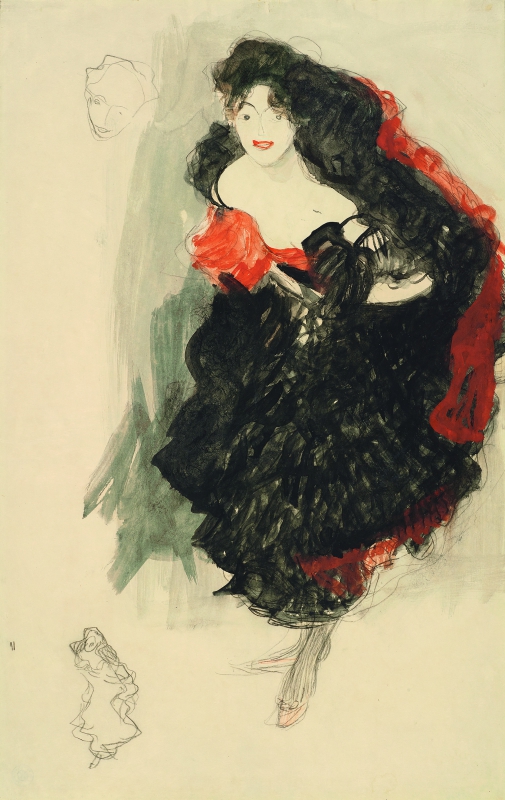
GUSTAV KLIMT
1862–1918
TÄNZERIN IM FLAMENCO-KOSTÜM,
STUDIE ZU „JUDITH II (SALOME)“, UM 1908
DANCER IN A FLAMENCO COSTUME,
STUDY FOR
“
JUDITH II (SALOME), C. 1908
Bleistift, roter Farbstift, schwarze Kreide, Gouache, Deckweiß auf Japanpapier
Pencil, red crayon, black chalk, gouache, opaque white on Japanese paper
55 × 34,9 cm
Leopold Museum, Wien
| Vienna
Foto
| Photo:
Leopold Museum, Wien
| Vienna/
Manfred Thumberger